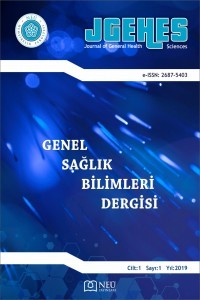Tip 2 Diyabeti Olan Yetişkin Bireylerde Ayak Bakım Davranışının Yordayıcıları: Öz Etkililik ve Yaşam Kalitesi
Tip-2 diyabet, Ayak öz-bakım davranışı, Öz-etkililik, Yaşam kalitesi, Hemşirelik
Predictors of Foot Care Behavior in Adults with Type-2 Diabetes: Self-Efficacy and Quality of Life
Type-2 diabetes, Foot self-care behavior, Self-efficacy, Quality of life,
___
- Abate, T. W., Tareke, M., & Tirfie, M. (2018). Self-care practices and associated factors among diabetes patients attending the outpatient department in Bahir Dar, Northwest Ethiopia. BMC Research Notes, 11(1), 800. https://doi.org/10.1186/s13104-018-3874-8.
- Ahmad Sharoni, S. K., Abdul Rahman, H., Minhat, H. S., Shariff-Ghazali, S., & Azman Ong, M. H. (2018). The effects of self-efficacy enhancing program on foot self-care behaviour of older adults with diabetes: A randomised controlled trial in elderly care facility, Peninsular Malaysia. PloS one, 13(3), e0192417. https://doi.org/10.1371/journal.pone.0192417
- Ahmad Sharoni, S. K., Mohd Razi, M. N., Abdul Rashid, N. F., & Mahmood, Y. E. (2017). Self-efficacy of foot care behaviour of elderly patients with diabetes. Malaysian Family Physician,12(2), 2–8.
- Yayın Aralığı: Yılda 3 Sayı
- Başlangıç: 2019
- Yayıncı: Necmettin Erbakan Üniversitesi
Postpartum Dönemdeki Kadınların Uyku Kalitesi ve Etkileyen Faktörler
Hemşirelikte Önemli Bir Kavram: Hemşirelikte Uzmanlık ve Ülkemizdeki Mevcut Durumu
COVİD 19 Tanısı Almış Bireylerin İyileşme Sonrası Yaşadıkları Semptomlar
Ali KAPLAN, Özlem KAPLAN, Serife CETİN
Açelya TÜRKMEN, İkbal ÇAVDAR, Nihat AKSAKAL
Burcu KÜÇÇÜK, Alime SELÇUK TOSUN
Covıd-19 Pandemisinin İnfertilite Tedavisi Gören Kadınlar Üzerindeki Etkileri: Kalitatif Çalışma
Özen İNAM, İlkay GÜNGÖR SATILMIŞ
Demans Hastalarına Bakım Verenlerin Öz Yeterliliği, Yaşam Kalitesi ve Bakım Yükü
Arzu BAHAR, Nilüfer ÖZGÜRBÜZ, Derya TAŞKIN ERDEM, Gamze Hilalcan DULKARA
Alzheimer Hastasının Gordon’un Fonksiyonel Sağlık Örüntüleri Modeli’ne Göre İncelenmesi: Olgu Sunumu
